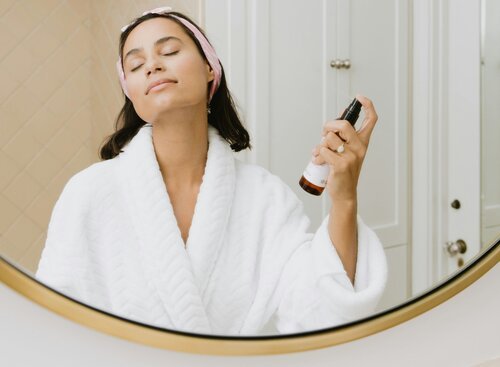
For centuries, women worldwide have risked their lives for beauty. During the Renaissance in Europe and in Victorian England, women used deadly nightshade, a dangerous plant that can cause paralysis or death, to lighten their skin or dilate their eyes for a desirable wide-eyed appearance, even though it could lead to blurred vision and blindness. In the eighteenth century, affluent women often used lead-based foundation, leading to cases of lead poisoning. In the 1930s in the United States, sixteen women suffered severe injuries or blindness after using an eyelash dye called Lash Lure, which contained the toxin paraphenylenediamine, still found in some hair dyes today.
Although these stories seem surprising, not much has changed over time. We continue to use beauty and personal-care products that can harm us, increasing risks of conditions like cancer and autoimmune disorders, and disrupting hormone and immune functions. This has prompted a surge in “clean” beauty marketed by retailers like Sephora, which promote items with fewer synthetic ingredients. However, there are no universal regulations for what qualifies as “clean,” meaning what is deemed safe by one company may not be agreed upon by another. I’ve learned some valuable insights to help you make informed choices without compromising your style or values.
Almost every product I used for my face, hair, skin, and nails contained harmful substances that interfered with hormone functions, impacted my immune system, and posed other health risks. I was essentially bathing in a cocktail of chemicals in the name of “beauty” and “hygiene.” I didn’t discard everything at once when I decided to improve my routine. Instead, I made thoughtful changes, focusing first on the products I used frequently in the shower. I replaced my conventional soap and mainstream hair care products with those rated 1 on the Environmental Working Group’s Skin Deep database. This free online tool rates the safety of over 96,000 products on a scale of 1 to 10, with 10 being the most hazardous.
Next, I considered what I applied in the largest amount to the broadest area: my moisturizing lotion. This was essential to change. Although early all-natural moisturizers didn’t have the same appealing scent as the fruity ones I was used to, I’m glad I stopped applying chemicals to my skin, which acts as an effective way to absorb substances into the body.
Not every switch was instantly successful. My first attempt at using a non-toxic face moisturizer led to breakouts, taking days for my body to adjust even though the ingredients were natural. The takeaway is that just because a product is labeled as clean doesn’t mean it will suit everyone’s skin or hair, much like conventional products with synthetic elements.
What may first appear as sacrifices often result in benefits for your health and looks. Initially, switching to a clean shampoo was frustrating; my hair stayed oily despite washing. But after a few weeks, my scalp balanced its oil production, meaning I needed fewer washes. My hair is now less damaged and feels healthier. It took a while to find a clean mascara I liked, so I reduced my usage of conventional ones until then. Decreasing your exposure can also mean changing habits to lessen the frequency of exposure to toxins.
Some Key Lessons On Finding Clean Personal-Care Products
Less is more
Believe me, you likely use more products than necessary. Reducing product use is the simplest way to cut down on your exposure to toxic chemicals. Fewer substances on your body, face, hair, and nails will improve their health and your overall radiance.
Trial and error are key
If non-toxic deodorants or toothpastes from years ago weren’t effective for you, try newer versions. They’re generally safer, more effective, better smelling, and user-friendly. Clean products vary greatly, so try different brands until you find what works best.
Don’t let perfect be the enemy of good
There’s no requirement to swap all your products when going clean. Utilize as many clean products as possible, but it’s fine to consciously choose to keep certain conventional items or services.
Go slow
Don’t feel the need to toss all your current personal-care products immediately. Start with one or two replacements, then opt for cleaner alternatives as you use up your existing items.
Prioritize what you use the most and the most frequently
Maximize impact by swapping out high-use, everyday items like soap, body lotion, shampoo, toothpaste, and sunscreen. For women, prioritize non-toxic deodorants and organic menstrual products, as traditional options could heighten cancer risks.
DIY Deodorant That Works
- 2½ teaspoons unrefined coconut oil
- 2½ teaspoons unrefined shea butter
- 2 teaspoons baking soda
- ½ cup arrowroot
- 6 drops lavender or orange essential oil
- 6 drops grapefruit essential oil
- 2 drops tea tree oil
Combine the coconut oil and shea butter in a glass bowl or jar and place in a medium saucepan filled with water. Heat the water to boil over medium heat, stirring the melted oils, then add baking soda, arrowroot, and essential oils. Transfer to a small jar and let it cool at room temperature. After cooling, cover and store in a cool, dry place. Apply with fingertips when needed.
Author Bio
Dr. Aly Cohen is a board-certified rheumatologist and integrative medicine physician with national recognition for her expertise in environmental health and medical education. She authored “DETOXIFY: The Everyday Toxins Harming Your Immune System and How to Defend Against Them,” revealing the connections between everyday chemicals and the rise in immune disorders and autoimmune diseases, and what we can do about it. She teaches, lectures, and practices medicine in Princeton, New Jersey.





